-
 Bitcoin
Bitcoin $117400
-0.25% -
 Ethereum
Ethereum $3762
-0.57% -
 XRP
XRP $3.072
-1.57% -
 Tether USDt
Tether USDt $1.000
0.02% -
 BNB
BNB $786.5
-2.10% -
 Solana
Solana $175.6
-3.15% -
 USDC
USDC $0.9999
0.01% -
 Dogecoin
Dogecoin $0.2166
-2.88% -
 TRON
TRON $0.3268
-2.89% -
 Cardano
Cardano $0.7540
-3.38% -
 Hyperliquid
Hyperliquid $41.82
-3.43% -
 Sui
Sui $3.723
-2.44% -
 Stellar
Stellar $0.4030
-3.66% -
 Chainlink
Chainlink $17.47
-1.80% -
 Bitcoin Cash
Bitcoin Cash $568.2
1.00% -
 Hedera
Hedera $0.2531
-3.51% -
 Avalanche
Avalanche $23.09
-4.91% -
 Litecoin
Litecoin $109.6
1.22% -
 UNUS SED LEO
UNUS SED LEO $8.954
-0.09% -
 Toncoin
Toncoin $3.366
-0.23% -
 Ethena USDe
Ethena USDe $1.001
0.01% -
 Shiba Inu
Shiba Inu $0.00001269
-2.93% -
 Uniswap
Uniswap $9.816
-4.14% -
 Polkadot
Polkadot $3.754
-3.49% -
 Monero
Monero $308.0
-2.79% -
 Dai
Dai $1.000
-0.01% -
 Bitget Token
Bitget Token $4.497
-0.77% -
 Pepe
Pepe $0.00001117
-2.61% -
 Cronos
Cronos $0.1428
-0.40% -
 Aave
Aave $269.9
-4.24%
How do you read EMA on a crypto chart?
The EMA is a responsive crypto trading tool that emphasizes recent prices, helping traders spot trends, crossovers, and dynamic support/resistance levels.
Jul 30, 2025 at 12:36 pm
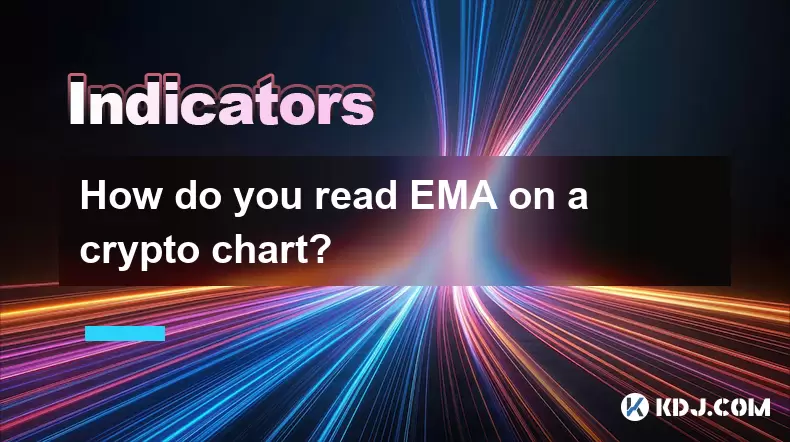
Understanding the EMA: What It Represents in Crypto Trading
The Exponential Moving Average (EMA) is a technical indicator widely used in cryptocurrency trading to identify trends and potential reversal points. Unlike the Simple Moving Average (SMA), which assigns equal weight to all data points, the EMA gives greater weight to recent price data, making it more responsive to new information. This responsiveness is especially valuable in the fast-moving crypto markets, where prices can shift rapidly due to news, market sentiment, or macroeconomic factors. When you look at an EMA on a crypto chart, you're viewing a smoothed line that tracks the average price of an asset over a specified number of periods—commonly 9, 20, 50, or 200 candles.
The core purpose of the EMA is to filter out market noise and highlight the underlying trend. A rising EMA suggests that the market is in an uptrend, while a falling EMA indicates a downtrend. Traders often use multiple EMAs simultaneously to gain deeper insights. For example, plotting both the 9-period and 21-period EMA can help identify short-term momentum versus medium-term trend direction. The proximity of price action to the EMA line also provides clues: if the price is consistently above the EMA, it reflects bullish sentiment; if below, it signals bearish pressure.
Setting Up EMA on a Crypto Chart
To begin reading the EMA, you must first add it to your charting platform. Most crypto exchanges and third-party tools like TradingView, Binance, or Coinbase Pro allow you to overlay EMAs. Navigate to the indicators section, search for "Moving Average," and select "Exponential." A configuration window will appear where you can define the settings:
- Choose the period length (e.g., 9, 20, 50)
- Select the price source (usually "close" price)
- Customize the color and thickness for visibility
- Decide whether to apply it to the main chart or a separate pane
Once applied, the EMA appears as a smooth line that follows price movements. You can add multiple EMAs by repeating the process. For instance, many traders use a dual EMA strategy with a short-term (e.g., 9) and long-term (e.g., 21) to detect crossovers. Ensure the chart time frame (1-hour, 4-hour, daily) aligns with your trading strategy, as EMA behavior varies across different intervals.
Interpreting EMA Crossovers for Entry and Exit Signals
One of the most common uses of EMA is identifying crossover signals. A bullish crossover occurs when a shorter-period EMA crosses above a longer-period EMA, suggesting upward momentum. Conversely, a bearish crossover happens when the shorter EMA crosses below the longer one, indicating potential downward movement.
For example:
- When the 9 EMA crosses above the 21 EMA, it may signal a buying opportunity
- When the 9 EMA crosses below the 21 EMA, it could prompt a sell or short entry
- These signals are more reliable when confirmed by volume spikes or candlestick patterns
Traders often wait for the crossover to complete and the price to retest the longer EMA as support or resistance before acting. It’s crucial to note that crossovers can produce false signals in sideways markets, so combining them with other indicators like RSI or MACD improves accuracy.
Using EMA as Dynamic Support and Resistance
The EMA doesn’t only indicate trend direction—it also acts as dynamic support or resistance. In an uptrend, the price may pull back to test the EMA line before bouncing upward. If the EMA holds as support, it reinforces the bullish trend. Similarly, in a downtrend, the EMA can act as resistance, where price attempts to rally but fails to break above it.
Key observations include:
- A strong uptrend often sees price hovering above the 20 EMA
- In a downtrend, price tends to stay below the 50 EMA
- A break below a key EMA (e.g., 200 EMA on daily chart) may signal a major trend reversal
- Repeated touches of the EMA without a break suggest consolidation
When price approaches the EMA, traders watch for rejection candles like pin bars or engulfing patterns to time entries. The effectiveness of EMA as support/resistance increases with higher time frames and longer EMA periods.
Combining EMA with Other Indicators for Confirmation
Relying solely on EMA can lead to misleading signals, especially in volatile crypto markets. To enhance reliability, traders combine EMA with complementary tools. The Relative Strength Index (RSI) helps identify overbought or oversold conditions when price approaches the EMA. For example, if price touches the 50 EMA in an uptrend and RSI is below 30, it may indicate a strong buying opportunity.
Another effective pairing is EMA with volume indicators. A breakout above the 20 EMA accompanied by rising volume confirms strong buying pressure. Conversely, a drop below the EMA on low volume might be a false breakdown. MACD is also useful: when MACD lines cross in the same direction as an EMA crossover, it strengthens the signal.
Some traders use Bollinger Bands alongside EMA. If price touches the lower band and the EMA is sloping upward, it may suggest a reversal is imminent. The key is ensuring that multiple indicators align before making a trade decision.
Common Mistakes When Reading EMA on Crypto Charts
Many traders misinterpret EMA due to common pitfalls. One major error is using too many EMAs on a single chart, which clutters the view and creates confusion. Limiting to two or three key EMAs improves clarity. Another mistake is applying EMA signals without considering the broader market context—such as news events or Bitcoin’s overall trend, which heavily influences altcoins.
Additionally, some traders act on EMA crossovers during low-volume periods or on very short time frames (like 1-minute charts), where noise dominates. It’s better to use EMAs on 1-hour or higher time frames for more reliable signals. Lastly, failing to adjust EMA settings based on market volatility can reduce effectiveness. In highly volatile conditions, a longer EMA (e.g., 50 instead of 20) may provide more stable guidance.
Frequently Asked Questions
What is the difference between EMA and SMA in crypto trading?
The EMA (Exponential Moving Average) reacts faster to recent price changes because it assigns more weight to newer data. The SMA (Simple Moving Average) treats all prices equally over the period. In fast-moving crypto markets, EMA is preferred for timely signals, while SMA is smoother but slower.
Which EMA periods are most commonly used by crypto traders?
Popular EMA periods include 9, 20, 50, and 200. The 9 and 20 are used for short-term trends, 50 for medium-term, and 200 for long-term trend analysis. Day traders often watch the 9 and 21 EMA crossover, while investors monitor the 200 EMA on daily charts.
Can EMA be used effectively in sideways or ranging markets?
In ranging markets, EMA can produce frequent false signals due to price oscillating around the line. It’s less effective here unless combined with oscillators like RSI or Stochastic to identify overbought/oversold levels at EMA touchpoints.
How do I know if an EMA signal is strong or weak?
A strong EMA signal is confirmed by high trading volume, alignment with higher time frame trends, and support from other indicators like MACD or RSI. A weak signal occurs in low volume, choppy price action, or contradicts broader market direction.
Disclaimer:info@kdj.com
The information provided is not trading advice. kdj.com does not assume any responsibility for any investments made based on the information provided in this article. Cryptocurrencies are highly volatile and it is highly recommended that you invest with caution after thorough research!
If you believe that the content used on this website infringes your copyright, please contact us immediately (info@kdj.com) and we will delete it promptly.
- LYNO Token Presale: AI Arbitrage Revolution in DeFi
- 2025-07-31 05:11:11
- Pepecoin Successors: Can These Cryptocurrencies Make You a Millionaire?
- 2025-07-31 05:50:12
- AML Bitcoin Fraud: Cracking Down on Crypto Crime in the Big Apple and Beyond
- 2025-07-31 04:33:53
- Cardano (ADA) in 2025: Navigating Crypto's Future
- 2025-07-31 03:52:07
- Solana Meme Coin Price Prediction: Will the Frog Outleap the Dog?
- 2025-07-31 03:52:07
- Bitcoin's Bullish Outlook: CryptoQuant's Insights on Futures Market Cooling
- 2025-07-31 03:59:10
Related knowledge

How does the VWAP line help in identifying overbought and oversold market conditions?
Jul 31,2025 at 05:19am
Understanding the VWAP Line and Its Role in Technical AnalysisThe Volume Weighted Average Price (VWAP) is a critical tool used by traders within the c...
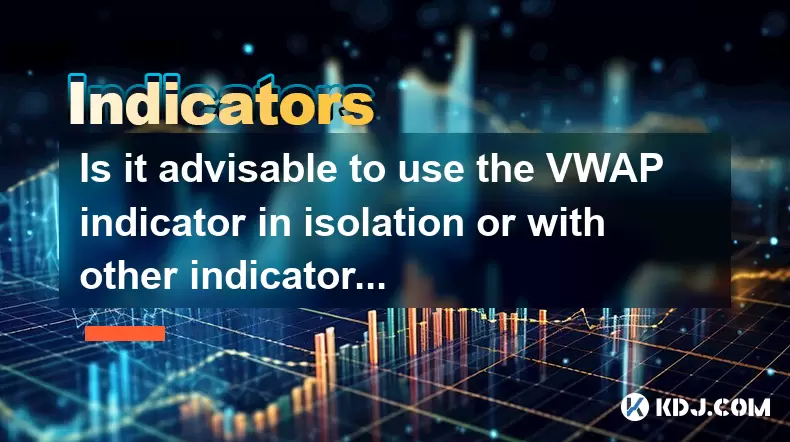
Is it advisable to use the VWAP indicator in isolation or with other indicators?
Jul 31,2025 at 06:48am
Understanding the VWAP Indicator and Its Core FunctionalityThe Volume Weighted Average Price (VWAP) is a widely used technical analysis tool in the cr...
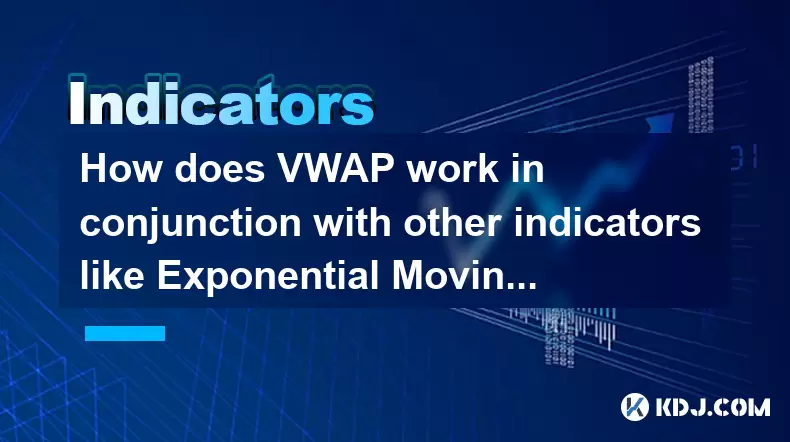
How does VWAP work in conjunction with other indicators like Exponential Moving Averages (EMAs)?
Jul 31,2025 at 04:38am
Understanding VWAP and Its Role in Crypto TradingThe Volume Weighted Average Price (VWAP) is a critical analytical tool in cryptocurrency trading, par...
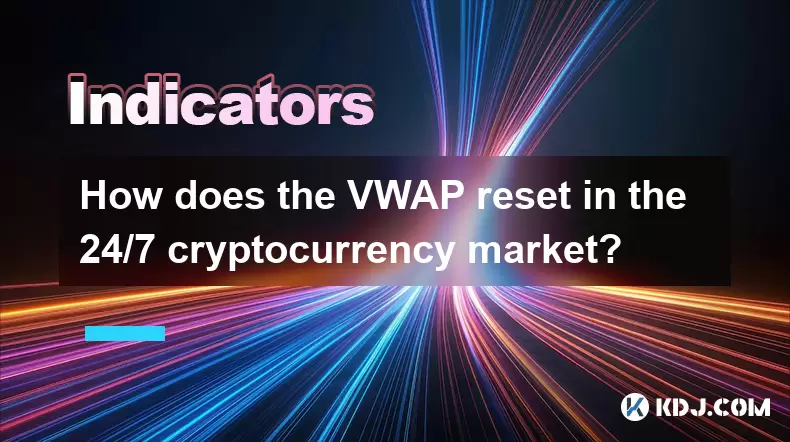
How does the VWAP reset in the 24/7 cryptocurrency market?
Jul 31,2025 at 06:38am
Understanding VWAP in Cryptocurrency MarketsThe Volume Weighted Average Price (VWAP) is a trading benchmark that calculates the average price of an as...

What exactly does the VWAP indicator measure?
Jul 31,2025 at 03:26am
Understanding the Core Concept of VWAPThe VWAP (Volume Weighted Average Price) indicator measures the average price of a financial asset, weighted by ...
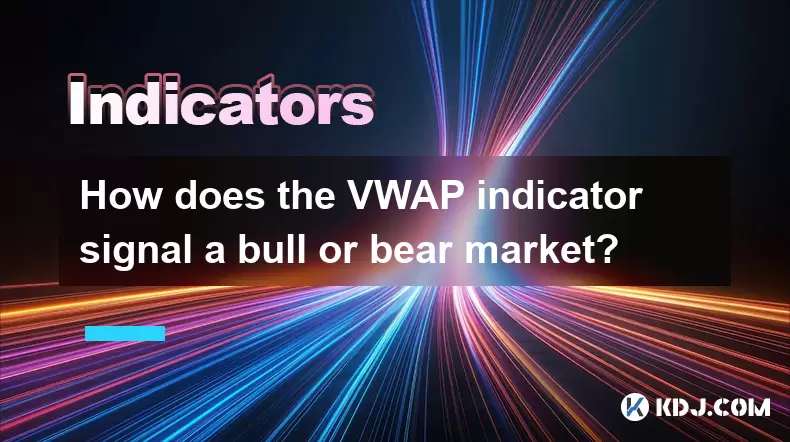
How does the VWAP indicator signal a bull or bear market?
Jul 31,2025 at 02:57am
Understanding the VWAP Indicator in Cryptocurrency TradingThe Volume Weighted Average Price (VWAP) is a widely used technical analysis tool in cryptoc...

How does the VWAP line help in identifying overbought and oversold market conditions?
Jul 31,2025 at 05:19am
Understanding the VWAP Line and Its Role in Technical AnalysisThe Volume Weighted Average Price (VWAP) is a critical tool used by traders within the c...

Is it advisable to use the VWAP indicator in isolation or with other indicators?
Jul 31,2025 at 06:48am
Understanding the VWAP Indicator and Its Core FunctionalityThe Volume Weighted Average Price (VWAP) is a widely used technical analysis tool in the cr...

How does VWAP work in conjunction with other indicators like Exponential Moving Averages (EMAs)?
Jul 31,2025 at 04:38am
Understanding VWAP and Its Role in Crypto TradingThe Volume Weighted Average Price (VWAP) is a critical analytical tool in cryptocurrency trading, par...

How does the VWAP reset in the 24/7 cryptocurrency market?
Jul 31,2025 at 06:38am
Understanding VWAP in Cryptocurrency MarketsThe Volume Weighted Average Price (VWAP) is a trading benchmark that calculates the average price of an as...

What exactly does the VWAP indicator measure?
Jul 31,2025 at 03:26am
Understanding the Core Concept of VWAPThe VWAP (Volume Weighted Average Price) indicator measures the average price of a financial asset, weighted by ...

How does the VWAP indicator signal a bull or bear market?
Jul 31,2025 at 02:57am
Understanding the VWAP Indicator in Cryptocurrency TradingThe Volume Weighted Average Price (VWAP) is a widely used technical analysis tool in cryptoc...
See all articles

























































































